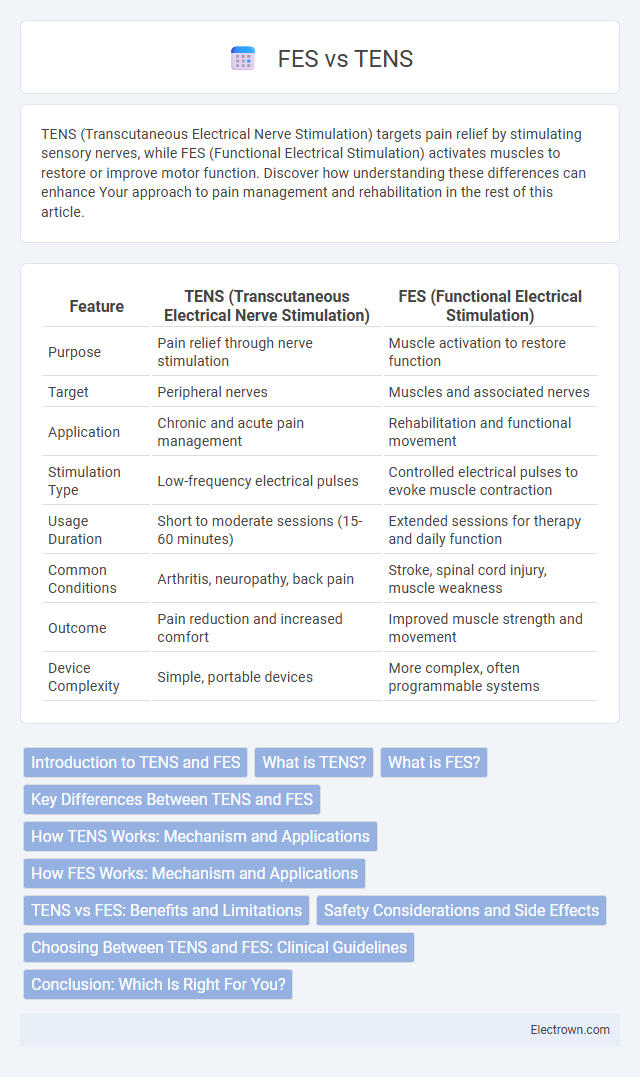TENS (Transcutaneous Electrical Nerve Stimulation) targets pain relief by stimulating sensory nerves, while FES (Functional Electrical Stimulation) activates muscles to restore or improve motor function. Discover how understanding these differences can enhance Your approach to pain management and rehabilitation in the rest of this article.
Table of Comparison
| Feature | TENS (Transcutaneous Electrical Nerve Stimulation) | FES (Functional Electrical Stimulation) |
|---|---|---|
| Purpose | Pain relief through nerve stimulation | Muscle activation to restore function |
| Target | Peripheral nerves | Muscles and associated nerves |
| Application | Chronic and acute pain management | Rehabilitation and functional movement |
| Stimulation Type | Low-frequency electrical pulses | Controlled electrical pulses to evoke muscle contraction |
| Usage Duration | Short to moderate sessions (15-60 minutes) | Extended sessions for therapy and daily function |
| Common Conditions | Arthritis, neuropathy, back pain | Stroke, spinal cord injury, muscle weakness |
| Outcome | Pain reduction and increased comfort | Improved muscle strength and movement |
| Device Complexity | Simple, portable devices | More complex, often programmable systems |
Introduction to TENS and FES
Transcutaneous Electrical Nerve Stimulation (TENS) utilizes low-voltage electrical currents to relieve pain by stimulating sensory nerves and blocking pain signals to the brain. Functional Electrical Stimulation (FES) applies electrical pulses to activate muscles in individuals with neurological impairments, aiding in motor function restoration and rehabilitation. Both therapies employ electrical stimulation but differ in their primary targets: TENS focuses on sensory nerve modulation for pain management, while FES targets motor nerves to facilitate muscle contractions.
What is TENS?
Transcutaneous Electrical Nerve Stimulation (TENS) is a non-invasive pain relief technique that delivers low-voltage electrical currents through the skin to stimulate nerve fibers. TENS units target sensory nerves to reduce pain signals sent to the brain and promote the release of endorphins, the body's natural painkillers. Commonly used for chronic and acute pain management, TENS is effective in conditions such as arthritis, neuropathy, and postoperative pain.
What is FES?
Functional Electrical Stimulation (FES) uses low-level electrical currents to activate muscles that have been weakened or paralyzed due to injury or neurological conditions. Unlike TENS, which primarily targets pain relief by stimulating sensory nerves, FES directly stimulates motor nerves to restore or improve muscle function and movement. You can utilize FES to support rehabilitation by promoting muscle strength, reducing atrophy, and enhancing motor control in affected limbs.
Key Differences Between TENS and FES
TENS (Transcutaneous Electrical Nerve Stimulation) primarily targets pain relief by stimulating sensory nerves, whereas FES (Functional Electrical Stimulation) activates motor nerves to induce muscle contractions for functional movements. TENS devices deliver low-frequency electrical pulses to modulate pain signals, while FES systems provide patterned stimulation synchronized with voluntary movement to restore muscle function. The key difference lies in TENS focusing on analgesia and FES on rehabilitation and muscle re-education.
How TENS Works: Mechanism and Applications
Transcutaneous Electrical Nerve Stimulation (TENS) delivers low-voltage electrical currents through the skin to activate sensory nerve fibers, which inhibit pain signals within the spinal cord via the gate control theory. This mechanism effectively reduces acute and chronic pain in conditions such as arthritis, neuropathy, and postoperative recovery. Common applications of TENS include managing musculoskeletal pain, improving circulation, and enhancing patient comfort during physical therapy.
How FES Works: Mechanism and Applications
Functional Electrical Stimulation (FES) activates paralyzed muscles by delivering low-level electrical currents via electrodes, mimicking natural nerve signals to restore movement and improve muscle function. This technology is primarily used in rehabilitation for stroke, spinal cord injury, and multiple sclerosis patients to enhance motor control and prevent muscle atrophy. FES facilitates neuroplasticity, promoting neural pathway recovery while supporting functional tasks such as walking, grasping, and cycling.
TENS vs FES: Benefits and Limitations
TENS (Transcutaneous Electrical Nerve Stimulation) primarily offers pain relief by stimulating sensory nerves, making it effective for managing chronic and acute pain but limited in promoting muscle activation. FES (Functional Electrical Stimulation) targets motor nerves to induce muscle contractions, aiding in muscle re-education and rehabilitation, especially after neurological injuries. While TENS is non-invasive and user-friendly for pain management, FES provides functional benefits in restoring movement but requires more complex setup and clinical supervision.
Safety Considerations and Side Effects
TENS (Transcutaneous Electrical Nerve Stimulation) generally presents minimal safety risks with common side effects including skin irritation and mild discomfort at electrode sites, but it should be avoided in patients with pacemakers or epilepsy. FES (Functional Electrical Stimulation) involves more intense muscle contractions, carrying risks such as muscle fatigue, soreness, and in rare cases, skin burns or autonomic dysreflexia in individuals with spinal cord injuries. Both therapies require proper electrode placement and dosage control to minimize adverse reactions and ensure safe application.
Choosing Between TENS and FES: Clinical Guidelines
Choosing between TENS (Transcutaneous Electrical Nerve Stimulation) and FES (Functional Electrical Stimulation) depends on your specific clinical goals, such as pain relief or muscle re-education. Clinical guidelines recommend TENS primarily for managing acute and chronic pain by stimulating sensory nerves, whereas FES targets motor nerves to restore or enhance muscle function in cases of paralysis or weakness. Assessing patient condition, treatment objectives, and contraindications helps healthcare providers select the most effective modality.
Conclusion: Which Is Right For You?
TENS (Transcutaneous Electrical Nerve Stimulation) targets pain relief by stimulating sensory nerves, while FES (Functional Electrical Stimulation) promotes muscle activation and rehabilitation. Your choice depends on whether you need pain management or muscle function restoration--the former suits chronic pain, the latter benefits motor impairment recovery. Consulting a healthcare professional ensures that your treatment aligns with specific therapeutic goals and medical conditions.
TENS vs FES Infographic

 electrown.com
electrown.com